Last updated on April 21st, 2024 at 07:19 am
Indoor plants do more than look nice – they make our living spaces healthier and happier. One big plus is their ability to clean the air by soaking up harmful stuff like formaldehyde and benzene while giving out oxygen. Besides being air cleaners, these plants add a natural touch to our indoors with their different shapes and colors.
Studies say they’re good for our minds too, helping us feel less stressed and more content. Taking care of them is like a soothing hobby. Indoor plants can also boost how much work or studying we get done, making the atmosphere positive. Some even help with humidity, making the air just right, and cool things down a bit. Plus, certain plants can quiet down the background noise, making our spaces calmer.
So, having indoor plants isn’t just about looks – it’s an easy way to make our homes and workplaces healthier and happier places to be.
Contents
Popular Low Maintenance Indoor Plants
Snake plant:
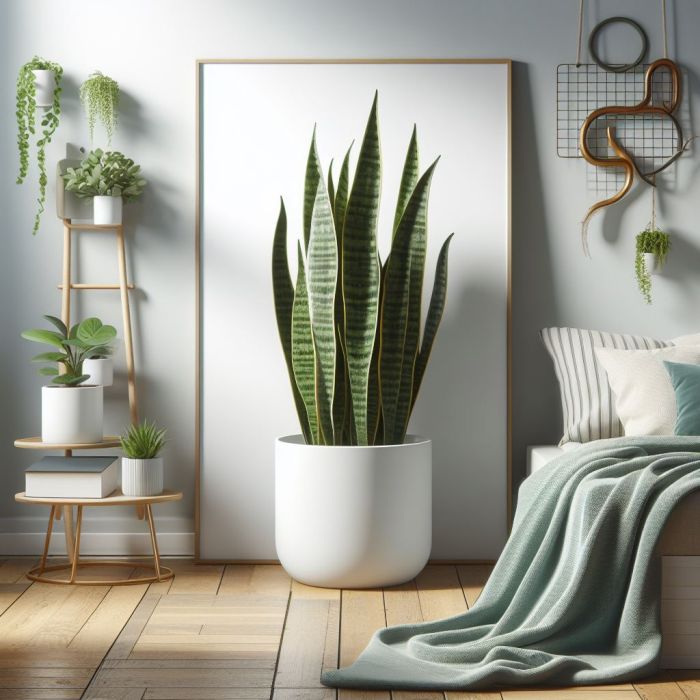
The Snake Plant, scientifically known as Sansevieria, boasts an elegant design characterized by bold, upright leaves that enhance the aesthetics of any indoor space. With vibrant shades of green and occasional yellow edges, its sleek architectural features make it a visually appealing choice for home decor.
Benefits and Suitability for Beginners:
This resilient plant is an excellent option for novice indoor gardeners. Its adaptability to various light conditions, from bright to low light, makes it a versatile choice for homes with different lighting setups. The Snake Plant’s hardiness and forgiving nature make it an ideal selection for beginners exploring the world of indoor gardening.
Air-Purifying Qualities:
Beyond its aesthetic charm, the Snake Plant doubles as an air-purifying powerhouse. Known for its ability to filter out pollutants like formaldehyde and benzene, it contributes to creating a healthier indoor environment. This added benefit makes it a practical and valuable addition to any home.
Low-Maintenance Appeal:
For those new to plant care, the Snake Plant is one of the low-maintenance indoor plants. It can withstand irregular watering schedules and occasional neglect, making it a hassle-free choice for individuals with varying levels of gardening experience.
Care Tips:
To ensure the well-being of the Snake Plant, it is advisable to water sparingly, allowing the soil to dry between watering, and avoiding waterlogging. These simple care tips, coupled with their attractive appearance, position the Snake Plant as a perfect addition to any indoor garden, offering both style and simplicity.
Spider Plant
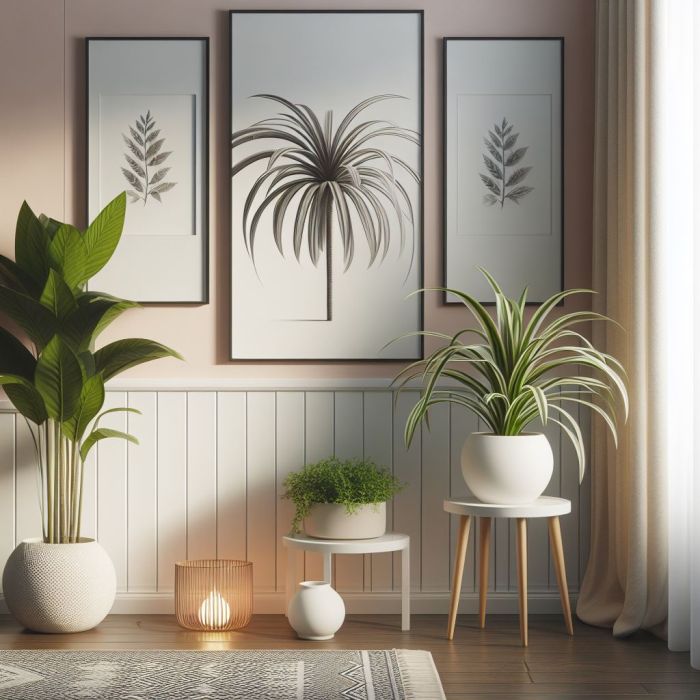
The Spider Plant stands out as a perfect addition to your indoor plants, boasting a distinctive appearance and easy-care qualities. Its arching leaves, resembling spider legs, introduce a unique charm to any indoor space. The lush green foliage adorned with delicate white stripes adds an elegant touch, making it visually appealing for homes.
Particularly well-suited for indoor gardening enthusiasts, the Spider Plant requires minimal attention and effortlessly adapts to various conditions. Whether showcased in hanging baskets or potted arrangements, the Spider Plant’s cascading leaves offer a versatile and decorative element to enhance your indoor plant collection. Elevate your space with the effortless elegance of this charming indoor plant.
Spider Plant: Effortless Elegance and Versatility for Your Indoor Oasis
Introducing the Spider Plant, a symbol of effortless elegance and versatility for your indoor garden. This charming indoor plant is celebrated for its distinctive appearance and user-friendly care routine. The arching leaves, reminiscent of spider legs, bring a unique and enchanting charm to any indoor space. Adorned with refreshing green foliage and delicate white stripes, the Spider Plant adds an elegant touch that complements various home aesthetics.
Ideal for both novice and experienced indoor gardeners, this plant requires minimal attention and gracefully adapts to diverse conditions. Whether displayed in hanging baskets or potted arrangements, the cascading leaves of the Spider Plant offer a versatile and decorative element to elevate the ambiance of your indoor oasis. Embrace the simplicity and beauty of the Spider Plant, making it a delightful addition to your indoor plants.
Beautiful Flowering Indoor Plants
Peace Lily
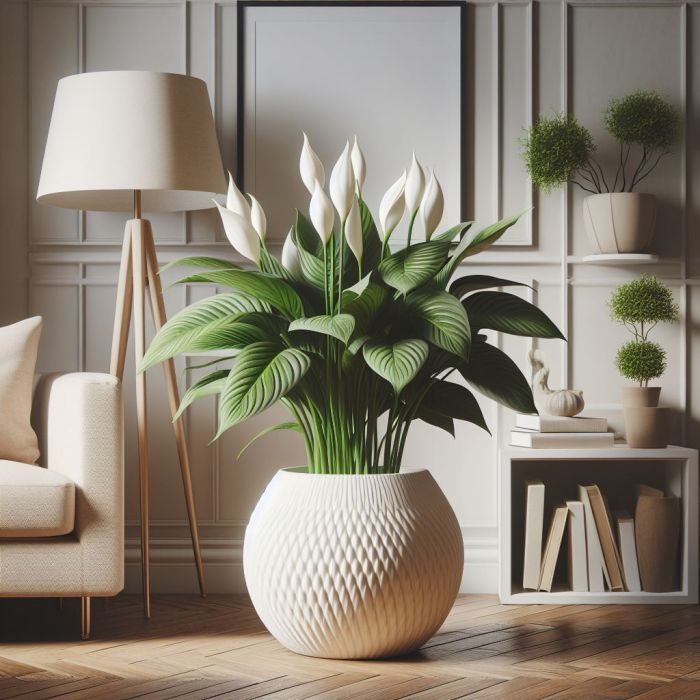
The Peace Lily celebrated for its refined appearance and distinctive blossoms, brings an air of grace to any household. Its dark green leaves and unique white flowers create an atmosphere of sophistication, making it a favored selection for indoor plants. The standout feature of the Peace Lily lies in its blooms – elegant, spoon-shaped flowers that add both visual charm and a sense of tranquility to indoor spaces.
Purifying Qualities:
Peace Lily is esteemed for its ability to purify the air. It effectively filters out common indoor pollutants such as benzene, ammonia, and formaldehyde, promoting a healthy indoor environment. This dual quality of beauty and air purification makes the Peace Lily a valuable choice for those seeking both visual allure and enhanced indoor air quality.
Watering and Light Care Tips:
Proper watering and lighting are essential for the well-being of the Peace Lily. It thrives in indirect, filtered light, adapting well to various indoor settings. Direct sunlight should be avoided to prevent leaf scorching. When it comes to watering, maintaining consistently moist soil is key. Water when the top inch of the soil feels dry, taking care not to overwater to prevent root rot. To mimic its natural habitat, consider misting the plant regularly or placing it in a humid environment to encourage optimal growth.
Orchids
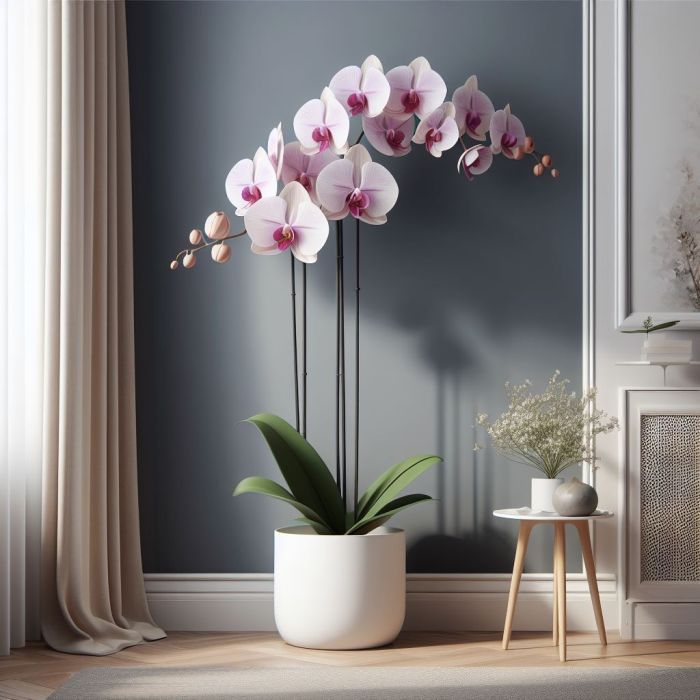
Renowned for their exquisite beauty, orchids offer a diverse array of species suitable for thriving indoors. The extensive range of orchid varieties, including the vibrant Phalaenopsis and delicate Cattleya, allows enthusiasts to select options that complement their home decor. Orchids, with their diverse shapes, colors, and sizes, bring a touch of sophistication and elegance to indoor gardens.
Creating an Optimal Environment:
Ensuring the right environment is pivotal for the successful indoor cultivation of orchids. Orchids generally flourish in bright, indirect light, making them well-placed near windows with filtered sunlight. Orchids also have temperature preferences, thriving in a daytime range of 70-80°F (21-27°C) and slightly cooler nighttime temperatures. Maintaining adequate humidity is essential, achieved by placing orchids on water-filled trays or regular misting to create a favorable microenvironment.
Essentials of Orchid Care:
Caring for orchids indoors requires attention to specific needs. Precise watering is crucial, necessitating a slightly dry potting mix between waterings to prevent root rot. Opting for a well-draining potting mix is advisable. Orchids benefit from regular fertilization during their growth season, receiving a balanced orchid fertilizer to ensure proper nourishment. Periodic repotting every 1-2 years helps refresh the potting mix and sustains the orchid’s health. Adequate air circulation around orchids is vital for disease prevention and overall well-being.
Indoor Herbs for Culinary Delights
Basil
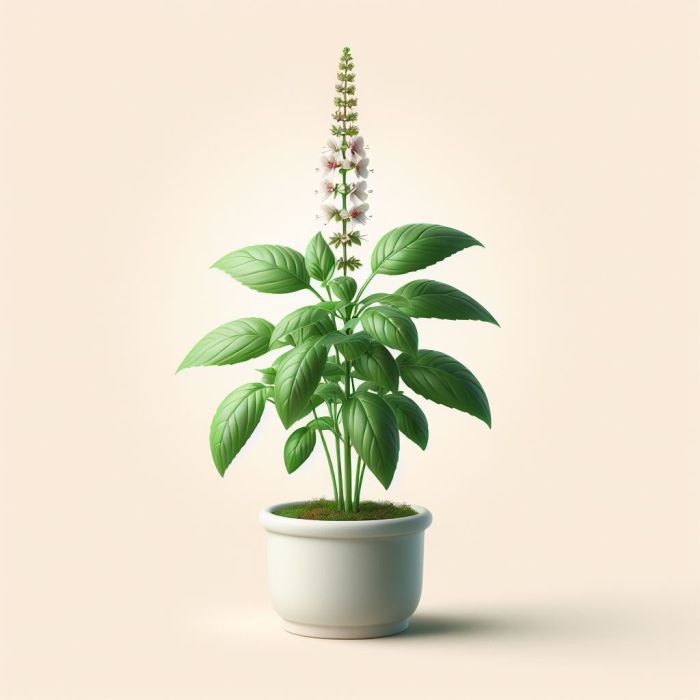
Basil, with its aromatic leaves and diverse flavor profiles, stands out as a fantastic culinary herb that can be easily grown indoors. Its culinary applications are extensive, adding a burst of freshness and depth to various dishes, from pasta and salads to the creation of flavorful pesto sauces. The aromatic essence of basil makes it a versatile and essential herb in the kitchen, elevating the taste of a wide range of cuisines.
Sunlight and Watering Requirements:
Understanding the sunlight and watering needs of basil is crucial for successful indoor cultivation. Basil flourishes in bright, indirect light, making it well-suited for locations near windows that provide filtered sunlight. Ample sunlight ensures robust growth and preserves the distinct flavor of the herb. When it comes to watering, basil prefers consistently moist soil. Water the plant when the top layer of soil feels dry, maintaining a balance to prevent both overwatering and underwatering. This careful approach helps avoid potential root issues and ensures the well-being of the basil plant.
Indoor Cultivation Suggestions:
Effective indoor cultivation of basil involves paying attention to specific tips. Opt for well-draining potting soil to prevent water stagnation, and choose a pot with drainage holes to facilitate proper water drainage. Regularly pinching off the growing tips of the basil plant encourages bushier growth and a more compact shape. Harvesting basil leaves frequently not only stimulates continuous growth but also provides a fresh supply of leaves for culinary endeavors. To enhance indoor cultivation, consider situating the basil plant alongside other herbs that share similar care requirements.
Mint
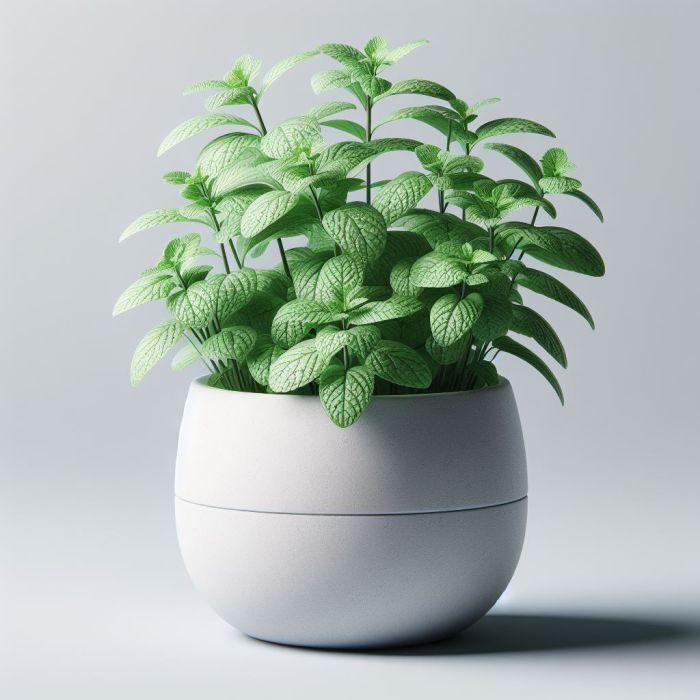
Mint, renowned for its refreshing fragrance and versatile culinary applications, makes a delightful addition to indoor gardens. The distinct scent of mint not only adds a pleasant aroma to your living space but also serves various culinary purposes. From flavoring teas and desserts to enhancing savory dishes, mint brings a burst of freshness and a hint of sweetness to a wide array of recipes.
Ideal Conditions for Growth:
Creating the ideal conditions for mint’s growth indoors involves understanding its preferences. Mint thrives in bright, indirect light, making it suitable for placement near windows with filtered sunlight. Adequate sunlight ensures robust growth and enhances the potency of its aromatic oils.
Mint prefers well-draining soil that retains moisture without becoming waterlogged. Maintaining a consistent watering schedule, allowing the top layer of soil to dry out before the next watering, contributes to optimal growth conditions.
Tips for Preventing Overgrowth and Maintenance:
Mint, known for its vigorous spreading habit, requires thoughtful care to prevent overgrowth and maintain a manageable size. Planting mint in a container or placing it in a designated area with barriers can help contain its growth. Regular harvesting, especially the pruning of the top leaves, not only promotes bushier growth but also prevents the plant from becoming overly leggy. Additionally, keeping an eye on its growth pattern and trimming any invasive runners contributes to a well-maintained and thriving mint plant.
Rosemary
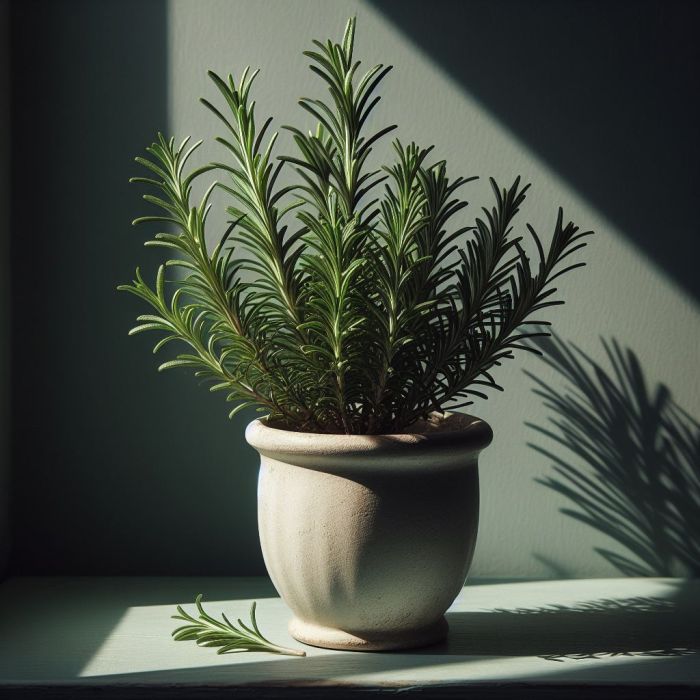
Rosemary, known for its culinary flexibility, introduces a blend of culinary excellence and delightful fragrance to indoor gardens. This aromatic herb is renowned for its ability to enhance an array of dishes, from savory meats and vegetables to various baked goods. Its robust and pine-like flavor elevates the taste profile of numerous recipes, establishing it as a favored choice in kitchens worldwide.
Sunlight and Watering Preferences:
Creating suitable conditions for indoor rosemary involves recognizing its preferences for sunlight and water. Rosemary thrives in bright, direct sunlight, making it well-placed near a sunny window, receiving at least six hours of sunlight daily. This exposure fosters the development of essential oils, intensifying both their flavor and fragrance.
When it comes to watering, rosemary prefers well-draining soil. Allow the top inch of the soil to dry out between waterings, preventing the risk of root rot. Maintaining a slightly drier soil emulates its native Mediterranean environment and supports healthier growth.
Pruning and Shaping Strategies:
Pruning and shaping are crucial practices for rosemary, promoting a fuller and more compact growth pattern. Regularly trim the tips of the stems to preserve the plant’s shape and stimulate lateral branch development. Focus on eliminating dead or woody stems to encourage fresh growth and sustain a vibrant appearance. Shaping rosemary involves selectively pruning the plant to achieve the desired form, whether a rounded shape or a well-defined silhouette. This not only contributes to an aesthetically pleasing indoor garden but also ensures a readily available supply of fresh rosemary for culinary endeavors.
Diverse Succulents and Cacti
Aloe Vera
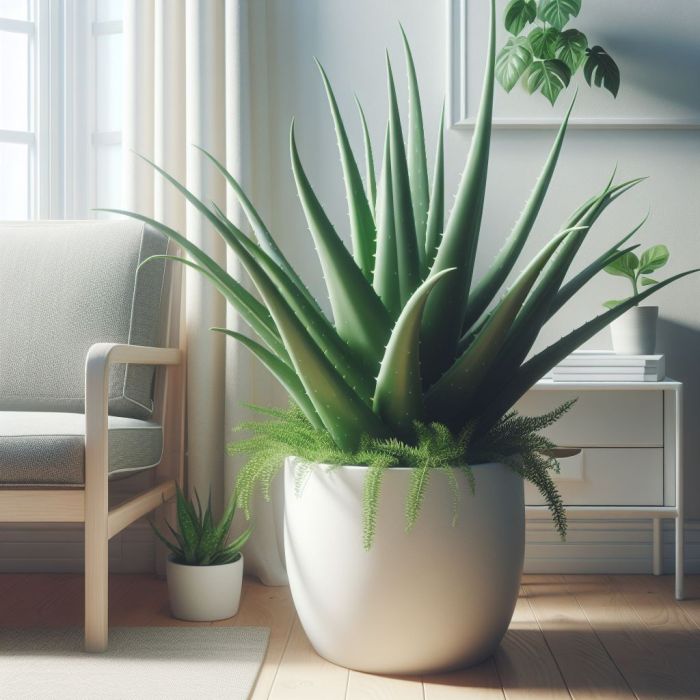
Aloe Vera, renowned for its exceptional healing properties, stands as a comforting haven in indoor plants. Beyond its decorative appeal, aloe vera has long been esteemed for its diverse therapeutic uses. The gel contained within its succulent leaves is famous for its ability to soothe burns, aid in skin healing, and alleviate skin irritations. Integrating aloe vera into your indoor garden not only introduces a touch of greenery but also offers a natural remedy for various skin-related concerns.
Sunlight and Watering Requirements:
Ensuring the flourishing health of indoor aloe vera involves understanding its preferences for sunlight and water. Aloe vera thrives in bright, indirect sunlight, making it suitable for positioning near windows with filtered sunlight. While it can tolerate some direct sunlight, excessive exposure may result in leaf discoloration.
Opting for a well-draining potting mix is essential to prevent waterlogging, as aloe vera prefers slightly drier soil conditions. Allow the top inch of the soil to dry before watering, maintaining a careful balance to prevent root rot and uphold the plant’s overall well-being.
Propagation Insights:
Propagating aloe vera can be a gratifying process, allowing for the expansion of your indoor garden effortlessly. The most common method involves utilizing offsets or “pups” – smaller shoots that grow around the base of the parent plant. Gently separate these offsets and plant them in their own containers with well-draining soil.
Ensure that the newly potted offsets receive the same sunlight and water conditions as mature aloe vera plants. Propagation from leaf cuttings is also feasible by allowing the cut ends to dry before planting them in soil. With diligent care, these propagated aloe vera plants can evolve into thriving additions to your indoor haven.
Jade Plant
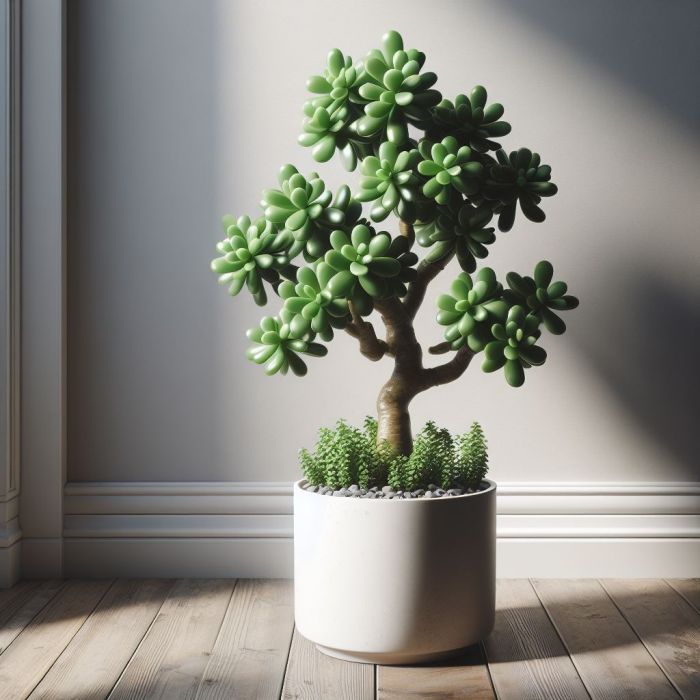
The Jade Plant, renowned for its symbolic significance and unique appearance, serves as a symbol of prosperity and good fortune across various cultures. Its fleshy, jade coin-like leaves are believed to attract wealth and positive energies, adding a touch of symbolic allure to indoor spaces.
Beyond its symbolic value, the jade plant captivates with its bonsai-like structure, featuring small, glossy leaves and robust stems that contribute to an elegant and captivating ambiance. This makes it a favored choice for those seeking both aesthetic appeal and positive symbolism in their indoor plants.
Effortless Care Requirements:
A notable feature of the Jade Plant is its minimal care needs, making it an excellent addition to indoor gardens, particularly for individuals with busy schedules. Thriving in bright, indirect sunlight, the jade plant exhibits resilience in low-light conditions. Watering should be done with caution, allowing the soil to dry out between intervals to prevent root rot.
A well-draining potting mix is essential for optimal health. With these straightforward care guidelines, the jade plant flourishes effortlessly, bringing natural beauty to indoor spaces with minimal effort.
Chic Enhancement to Indoor Settings:
The jade plant not only offers low-maintenance benefits but also acts as a stylish enhancement to indoor spaces. Its compact form and rich green tones make it a versatile plant that complements various interior aesthetics. Whether adorning windowsills, tabletops, or part of a succulent arrangement, the jade plant effortlessly elevates the overall decor of a room.
Its adaptability to different container styles and its ability to thrive in confined spaces contribute to its stylish appeal, making it an excellent choice for those aiming to introduce a touch of greenery into their indoor environments.
Essential Guidelines for Nurturing Indoor Plants
Ensuring the well-being of indoor plants involves adhering to fundamental care tips that contribute to their vitality. To start, strategic placement is crucial. Recognize the light preferences of each plant and position them accordingly, considering factors like bright, indirect sunlight, or low-light conditions. Tailoring their environment to these requirements significantly influences their overall health.
Proper watering practices are paramount to indoor plant care. Guard against overwatering by establishing a consistent schedule, allowing the soil to dry slightly between waterings. Adjust the frequency based on factors such as the plant’s type, size, and environmental conditions. Regularly assessing soil moisture levels prevents both under and overhydration.
Selecting the appropriate soil type is often overlooked but holds significant importance. Different plants favor specific soil compositions. Ensure your indoor plants are potted in well-draining soil mixes suited to their species, preventing waterlogged conditions and promoting proper aeration for root health.
Lastly, adopt an appropriate fertilization routine. Indoor plants generally require less fertilizer compared to their outdoor counterparts. Follow recommended guidelines for your specific plants, applying fertilizers during their growing season. This ensures the provision of necessary nutrients for robust growth without the risk of over-fertilization.
FAQs:
Why is proper placement crucial for indoor plants?
Proper placement ensures that indoor plants receive the right amount of light, considering their specific preferences. This significantly influences their overall health and appearance in indoor spaces.
What makes the Peace Lily a popular choice for indoor plants?
The Peace Lily is celebrated for its refined appearance and distinctive white flowers, adding grace to any household. It not only enhances aesthetics but also purifies indoor air by filtering out pollutants.
Which indoor plants are suitable for beginners?
Both the Snake Plant and the Jade Plant are excellent choices of indoor plants for beginners. They are resilient, adaptable to various light conditions, and have minimal maintenance requirements.
As you embark on your journey into the world of indoor plant care, remember that the lush greenery adorning your home is more than just a visual delight—it’s a living, breathing contributor to a healthier and happier living space. With the tips and insights shared in this guide, may your indoor oasis continue to thrive, bringing both style and tranquility to your surroundings. Whether you’re a seasoned plant enthusiast or just starting your green adventure, the joy of cultivating these indoor companions is boundless. So, water wisely, position thoughtfully, and watch as your stylish and stress-free indoor plants transform your home into a haven of natural beauty. Happy planting!

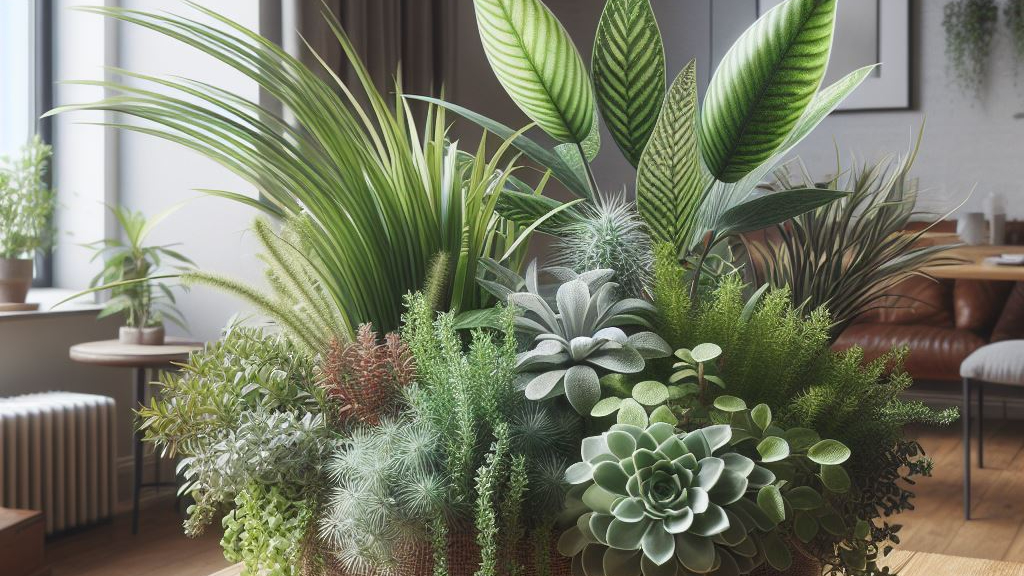
3 thoughts on “Indoor Plants: A Stylish and Stress-Free Guide to the Best Green Companions”